There are many different types of scarves out there that serve different functions and are made of different materials. From traditional neck scarves to head scarves to bandanas and even boas, when and how to wear each can be challenging.
There are 11 main types of scarves as far as the style and the scarf is concerned. These are:
- Antique
- Bandana
- Blanket
- Boa
- Cowl
- Infinity
- Muffler
- Sarong
- Shemagh
- Snood
- Triangle
There are five different scarf functions: beach, head, neck, winter, and decorative. Scarves can be made from many different materials also.
This guide will explain the different types of scarves and when and how to wear each one. I’ll start by covering the 11 types of scarves, followed by different scarf functions and scarf materials. I’ll even cover the types of scarves for guys as well.
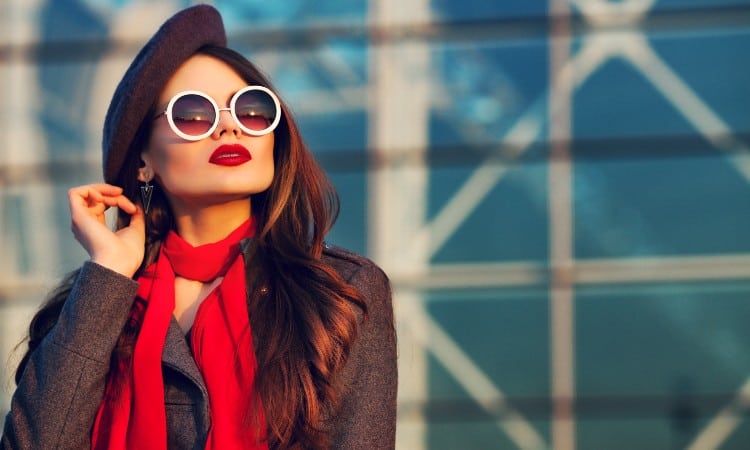
11 Types of Scarves
Unless you love wearing and accessorizing with scarves, you may not have known there are many different styles of scarves. There are 11, to be exact. Each of these 11 scarf types differs in length and size of the scarf. These scarves also have different shapes and different times when wearing them is ideal. Let’s dive in and explore them all.
1. Antique or Traditional
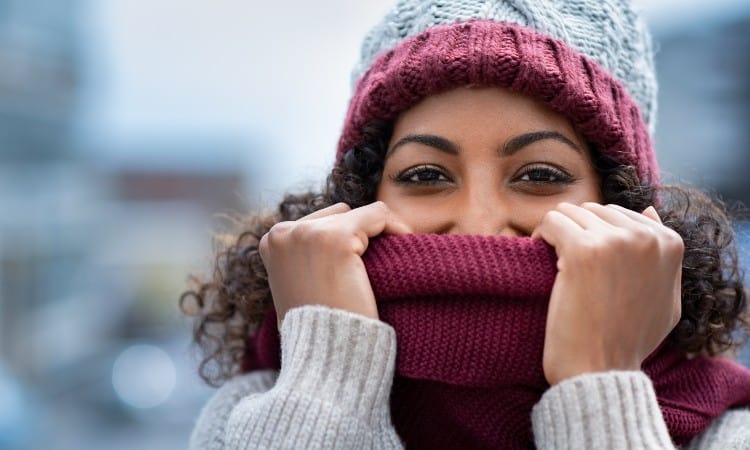
Antique scarves, also known as traditional scarves, probably come to mind when you think of a scarf. Think of a winter scene with people wearing warm coats, maybe a hat and gloves, and wearing a scarf around their necks. But, these scarves aren’t just meant for wearing in winter.
In reality, an antique or traditional scarf is any scarf with a rectangular shape. These scarves are typically around 4-5 feet in length. But they are quite wide and can be folded in half to make them more narrow if that is your intention. They may or may not have fringe or tassels on the end, but all antique scarves have that same basic shape. These scarves are commonly made from warm fabrics such as cashmere and wool but can be made from any material.
2. Bandana
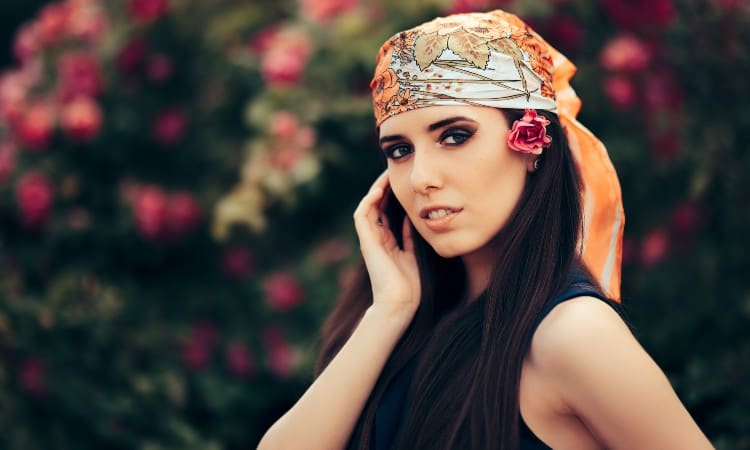
When we think of bandanas, we often think of square pieces of fabric, often with a paisley pattern. But did you know that bandanas are a type of scarf? Bandanas tend to have a triangle shape or can be folded into a triangle from the original square shape. They are usually made of cotton fabric. Bandanas come in different sizes, but most of them don’t exceed 20 inches in length.
Bandanas can be worn in many different ways. Some people prefer to tie them around their necks in a triangle shape. In this case, many people call them neckerchiefs, and some people use them as a headscarf to protect their hair or just as an accessory. Still, others may wear them tied around their wrists like a bracelet, but they are still scarves nonetheless.
3. Blanket
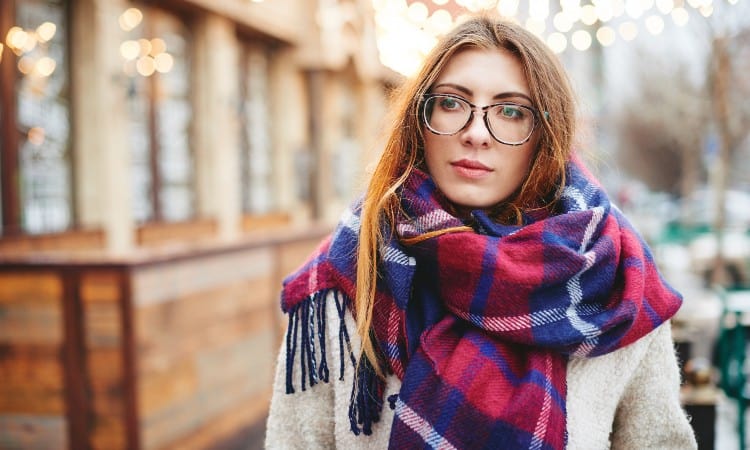
Blanket scarves are those big, billowy scarves that often come out in the fall. These scarves are usually made with plaid flannel fabric, so they function both to keep you warm and to accessorize. Blanket scarves are, without a doubt, the largest type of scarf. They are so large that they can double as a blanket, hence the name.
4. Boa or Stole
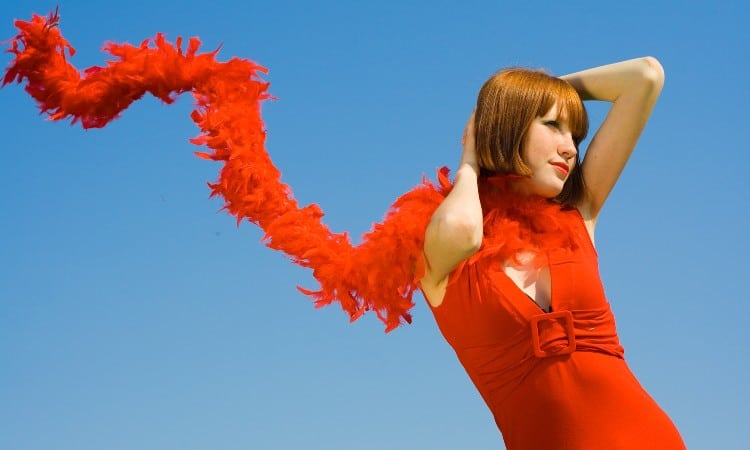
Another type of scarf you may be familiar with is the boa or stole. These scarves are generally worn around the neck and over the shoulders but aren’t intended to be tied like other scarves. Most boas and stoles are made of either real or faux fur, as well as fabrics such as wool and pashmina.
Traditional boas and stoles are meant to be worn in the winter, especially in colder climates. They are often seen as elegant and are generally worn to formal events. When you think of a boa, you may also think of a feather boa. This type of boa is usually worn for costume purposes and stage performances, longer than traditional boas or stoles but still considered a type of scarf.
5. Cowl
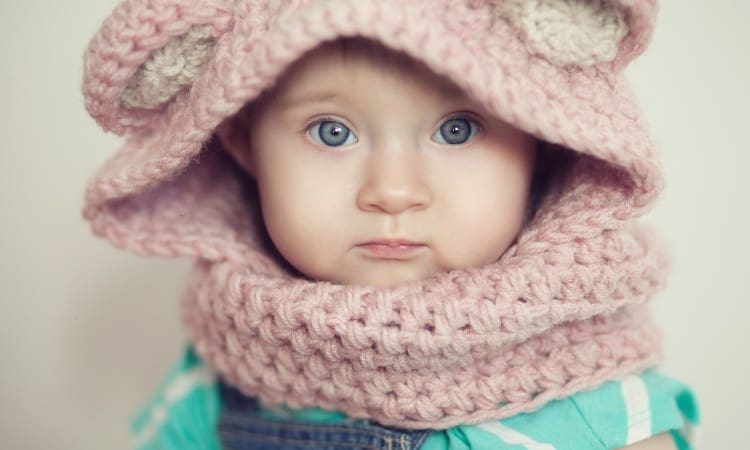
Cowl scarves, or cowl neck scarves, generally have a rounded shape that resembles a collar. They are usually worn in the fall and winter and do a great job keeping the neck warm. Many cowl scarves are also large enough that you can pull them up to help keep some of the face warm, although this isn’t their intended purpose.
Cowl scarves are often confused for infinity scarves but tend to be a little bit shorter and fuller. Many cowl scarves are made of knit fabrics or knitted with a waffle knit pattern, almost like wearing a sweater around your neck. But you can also find some made of lighter fabrics that can be worn when it’s a bit warmer outside.
6. Infinity
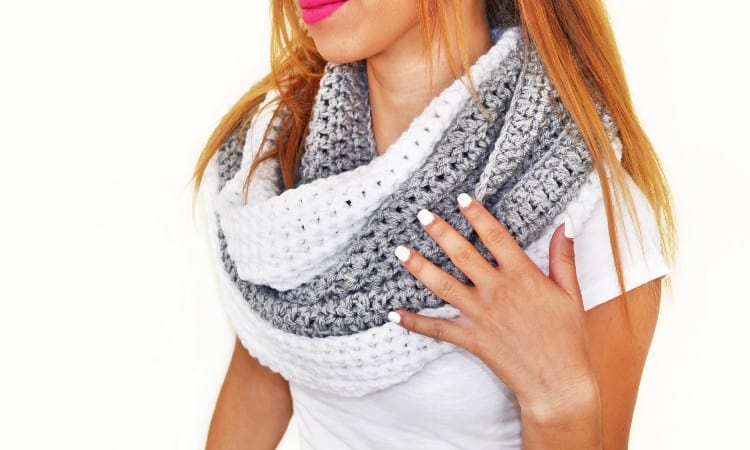
Infinity scarves have become more popular in recent years. Like the cowl scarf, they have a rounded shape with no beginning or end, like a traditional scarf. They can be slipped over the head and looped to make them fuller to keep the neck warmer.
Infinity scarves are generally longer and hang slightly lower than a cowl scarf. Another thing about infinity scarves is that many of them are made of more lightweight fabrics, such as cotton and linen. They are meant to be worn in warmer months since they don’t keep the neck as warm as cowl scarves. Some people wear infinity scarves purely for style purposes rather than function.
7. Muffler
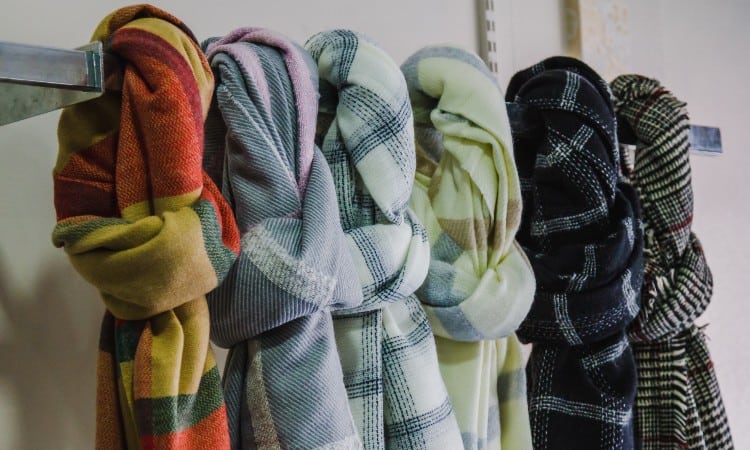
Muffler scarves are very similar to antique or traditional scarves, as they have the same basic rectangular shape and a similar length. The major difference between the two is that muffler scarves aren’t as wide as antique scarves. Many men opt for a muffler scarf, but they aren’t exclusive to men’s fashion.
Muffler scarves can be made out of a wide range of materials. You can purchase muffler scarves made of different fabrics and wear them year-round. Depending on the season, the common materials for muffler scarves are cotton, satin, and wool. They can be woven or knitted.
8. Sarong
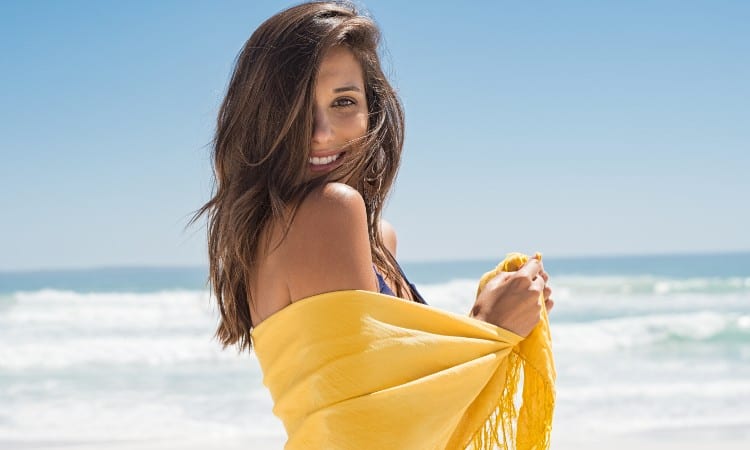
Sarongs are long and wide scarves, similar to a blanket scarf. But sarongs are generally made of more lightweight and breezy materials, such as cotton and linen. Sarongs aren’t meant to be worn around the neck. Instead, they are often worn around the torso, hips, and waist, similar to a dress or skirt, especially in warmer climates. Many people also wear them as beach cover-ups during the summer.
9. Shemagh
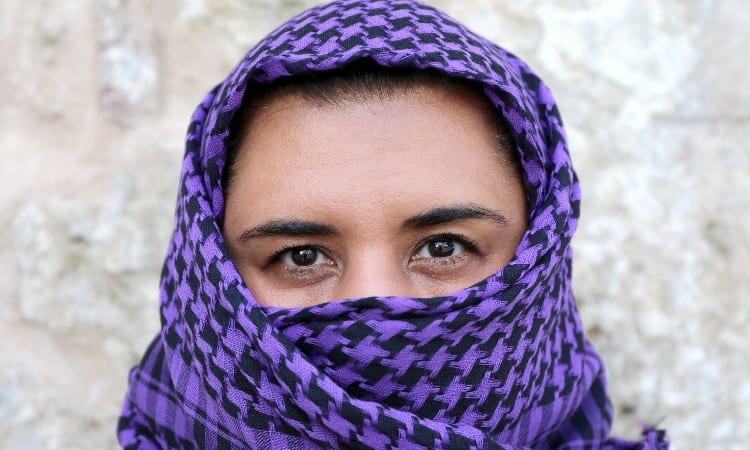
Shemagh (pronounced like schmog) scarves go by many different names, including keffiyeh and ghutrah. These scarves have their origins in the Middle East and are often worn by priests and other religious people in the Muslim faith, and are most commonly made from cotton fabric.
Shemaghs generally cover the neck, as well as the head and face. They originally served the practical and functional purpose of protecting the wearer from sun exposure, wind, and other elements. But today, many people around the world wear them for both function and fashion.
10. Snood
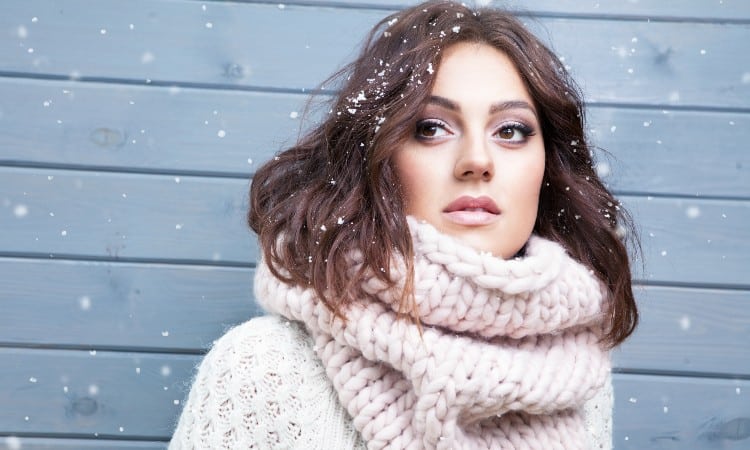
A snood is another type of large, circular scarf similar to infinity and cowl scarves, with one distinct difference. Snoods are meant to cover the neck and the lower part of the face and head to keep you warm in the winter. As a result, snoods often have a wider opening than cowl and infinity scarves. However, like cowls, most snoods are usually knitted.
11. Triangle
Triangle scarves are exactly like they sound. They have a triangular shape instead of rectangular like traditional and muffler scarves or rounded like cowl and infinity scarves. Triangle scarves are like a larger version of a bandana folded into a triangle but are meant to be worn around your neck like most other scarves.
When worn, a triangle scarf will drape to cover your chest in a triangle shape. Some triangle scarves are large enough to cover your shoulders completely, while others just rest on your shoulders. They can be made of many different materials, and as a result, can be worn year-round.
Different Scarf Functions
So now you know the different types of scarves. But scarves also have different functions, as you probably gathered while reading above. Here, I’ll discuss the different functions of scarves and mention which style of scarf best fits each function.
Beach Scarves
Beach scarves are worn around the torso and/or waist over a bathing suit. The most common type of beach scarf is a sarong, but any lightweight and flowy fabric that is large enough and in the right shape can serve as a beach scarf. The main thing to remember here is that beach scarves aren’t designed to keep you warm. They’re more for fashion and to cover up your bathing suit, whether on the beach or in another public space.
Headscarves
Headscarves are smaller scarves that are worn on the head. They are similar in size or slightly larger than a bandana. Shemaghs can be considered a type of headscarf as well. Head scarves can be made of many materials, but satin and silk are the most popular. Many people wear headscarves for function, as they can protect your head, hair, and scalp from sunburn, dust, and wind. However, some people wear them for fashion purposes as well.
Neck Scarves
Neck scarves are the traditional type of scarf. Most scarf styles are intended to be worn around the neck. There is a wide range of scarf options that are made from many different materials. They can be woven, knitted, and worn throughout the year for both function and fashion. Antique, blanket, cowl, infinity, muffler, snoods, and triangle scarves are all kinds of neck scarves.
Winter Scarves
Winter scarves are generally neck scarves but refer to warm scarves mainly worn in the winter. Of course, many people wear them as accessories, but they also serve the larger function of keeping your neck warm. Antique, blanket, cowl, muffler, and snood scarves are the most commonly considered winter scarves. Winter scarves are often made of warmer materials such as cashmere, alpaca, and wool.
Decorative
Decorative scarves are those that are mostly worn for fashion purposes rather than functional ones. They are used as accessories to an outfit and often come in pretty or unique patterned fabrics. Decorative scarves. Many of them are made from satin or silk, but they can also be made from other materials. Decorative scarves come in many different scarf styles and can be worn around the neck, head, or shoulders. Some people even tie smaller decorative scarves around their wrists, use them as purse accessories, or even tie them in their hair.
Types of Scarves for Guys
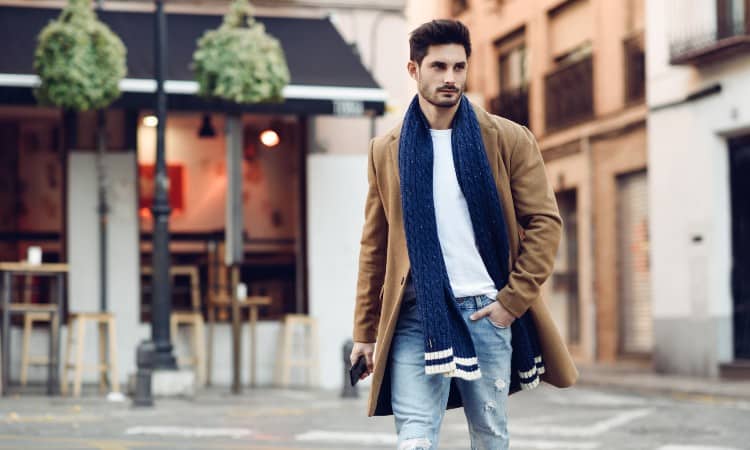
Scarves are much more prominent in women’s fashion. But many men also wear scarves, especially as the temperature drops. There are a few different types of scarves that men commonly wear. Let’s take a closer look.
Ascot

Technically, ascots are a type of necktie. But since they tie around the neck, some people also consider them to be a type of scarf since they are tied differently than traditional ties. Ascots are generally made of silk material. Men often wear ascots with suits to formal events.
Cowl
Cowl scarves aren’t as commonly worn by men as other styles of men’s scarves, but some men do wear them when it starts to get cold outside. Men’s cowl scarves tend to be smaller than women’s cowl scarves, but they are pretty similar in appearance and what they’re made of. Cowl scarves are worn more casually than other types of men’s scarves.
Muffler
I’ve already talked about mufflers, but remember that a muffler is one of the most traditional types of scarves. Muffler scarves are worn by men just as much as they are by women, especially in winter months. Muffler scarves can be worn casually with a coat and t-shirt and a suit for a day at the office. It’s one of the most versatile styles of men’s scarves.
Neckerchief
The final type of men’s scarf is a neckerchief. Neckerchiefs are square like bandanas are, but they are larger. They’re usually made of silk or cotton. This type of scarf was primarily worn as part of the uniform for scouts or those in the armed forces, particularly sailors. But they are now worn casually as well. Neckerchiefs are common among men, but many women wear them now too.
Best Fabrics For Scarves
As you can see, scarves are very versatile and there are many different materials that scarves can be made of. Let’s briefly look at some of the most common, including when these materials would be worn and how to care for them.
Acrylic
Acrylic is a type of synthetic fabric. It is lightweight, soft, and warm and is typically used for more casual scarves. It’s also used as a wool alternative. Traditional infinity and muffler scarves are commonly made out of acrylic fabric. Scarves made out of acrylic are best suited for spring and fall months while temperatures are still cool but not cold. You can wash acrylic scarves with other clothes. Just be careful to avoid high heat and try not to let the fabric snag.
Alpaca
Alpaca wool is used to make many different accessories, including socks, gloves, hats, and scarves. Alpaca is a very warm but expensive fabric and must be treated with care and either hand-washed or dry-cleaned. Due to its warmth, alpaca is normally used for traditional winter scarves and blanket scarves.
Cashmere
Cashmere is a fabric that comes from the wool of the cashmere goat. Like alpaca, it is very warm and soft but must be treated with care. Cashmere is also very expensive. This scarf material is worn in the winter and used to make traditional and blanket scarves.
Chiffon
Chiffon is a lightweight, airy sheer fabric usually made of cotton, silk, or synthetic fibers. Chiffon is used to make traditional scarves worn in warmer months but can also be used for sarongs, headscarves, and other decorative scarves. Caring for chiffon scarves means either having them dry-cleaned if they’re made of silk or hand-washing if they’re made of cotton since it is a delicate fabric. Chiffon made of synthetic fibers is more durable and can be machine-washed.
Cotton
Cotton can be used to make pretty much any type of scarf, from traditional to bandana, infinity to sarong, etc. Cotton scarves can be worn year-round depending on the type of cotton fabric and how the scarf is woven or knitted. Cotton scarves are also easy to care for and can be washed in the washing machine.
Fleece
Fleece is a synthetic version of wool fabric made from polyester fibers. It’s a warm fabric used mainly for winter scarves, especially traditional blanket and infinity scarves. Fleece can also be used as a scarf lining. Fleece scarves tend to be very durable and are easy to wash and keep clean.
Net
Net scarves are generally made from silk or nylon, depending on the scarf’s overall purpose and design. The fibers are usually woven together to create a mesh or net-like appearance. These scarves are mainly for decorative and fashion purposes. It’s easiest to spot clean or hand-wash them to prevent them from getting snagged or unraveling.
Pashmina
Pashmina is very similar to cashmere, but the fibers come from a different species of a mountain goat. The fibers tend to be a bit finer than cashmere, but the fabric is still very warm, soft, and lightweight and makes a great choice for winter scarves. Pashmina is also very expensive but delicate. It’s best to dry-clean it or wash it by hand.
Silk
Silk is one of the most common scarf materials for decorative scarves, headscarves and sarongs, and men’s neckties and ascots. Authentic silk is made out of natural silk fibers, but there is also artificial silk made out of synthetic fibers. Artificial silk is more durable and can be cleaned easier. Natural silk scarves should ideally be washed by hand.
Wool
Wool is one of the most common materials for different types of winter scarves. Wool is very warm but isn’t quite as delicate or expensive as fabrics like alpaca, cashmere, or pashmina. Most of the time, wool can be washed in the washing machine if you use the delicate cycle and avoid hot water. Or you can hand-wash it to be on the safe side.
How to Wear Different Types of Scarf
Traditional scarves are the most versatile for how you can wear them. There are many different ways to tie them. You can wear them in the classic loop, braid them, wear it as a shawl, or tie it in a French knot.
Here’s a video that shows 25 different ways to wear a scarf.
Bandanas and sarongs are also very versatile in how you can wear them. Bandanas can be tied around the neck if they’re large enough. You can also wear them on your head. Sarongs can be worn as a skirt or as a top or dress, just depending on how big they are.
Other types of scarves aren’t as versatile. There are only so many ways to wear a cowl, infinity, snood scarf, or stole.
Conclusion
So there you have it! Hopefully, this guide has made you more familiar with the different types of scarves and how and when you can wear them. You can wear a scarf for fashion or function in pretty much any season, and there are many ways to accessorize with them. If you enjoyed this article, share it with others and leave a comment. Thanks for reading!